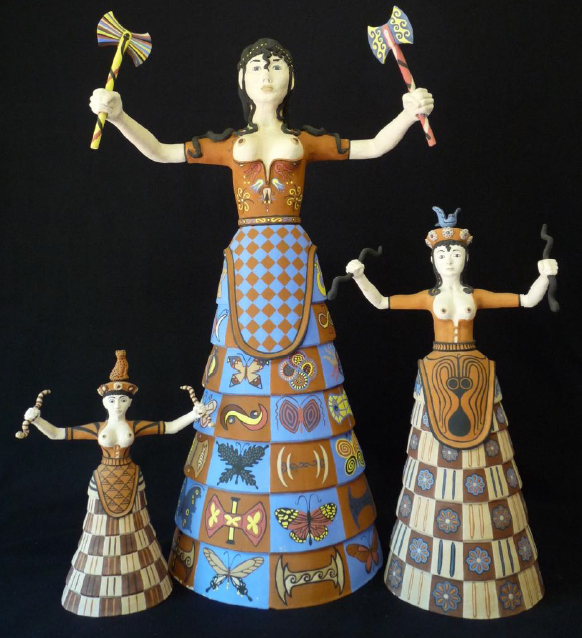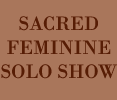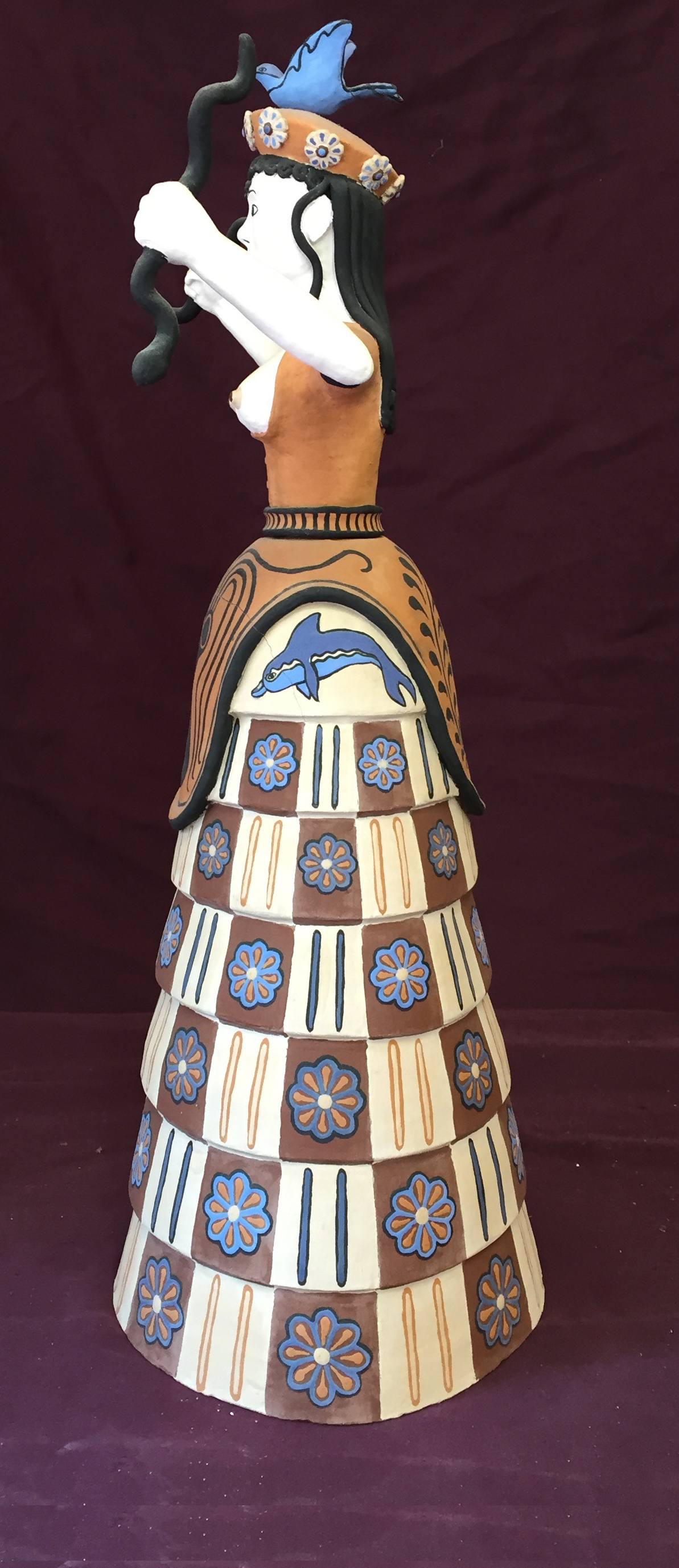
|
|
 |
About the Piece
The first of these
Goddesses (Goddess #1) is a replica of the Minoan Snake Goddess found
on the Island of Crete. In our patriarchal culture Goddess is hardly
acknowledged, if at all. My ideal is to show what would have happened
if Goddess were to have been historically handed down to us with the
same all encompassing impact as the male God: She would be ever
present. She would be infused into every aspect of our conscious and
unconscious minds, our language, myths, secular and religious
culture. By creating a series of these Minoan Snake Goddesses I am
trying to show what could have happened with the unimpeded evolution
of Goddess, each of the Goddesses gets progressively taller to
illustrate her evolving status.
Additionally, Goddesses
#1 represents the religion we are given by our parents. As we mature
we change, abstract, rearrange, subtract from and add to the original
religion until we have made it our own. The changing forms of
Goddesses #2 and #3 highlight this metamorphosis.
While Goddess #1 is a
replica, Goddess #2 incorporates other designs from the Minoan
culture. For instance, her flowered skirt design is found on the
walls of the Queen's Megaron at the palace of Knossos. The flora and
fauna found on Minoan vases graces her apron. In both Goddess #1 and
#2, the majority of the designs come directly from actual Minoan
artifacts. I have simply selected and rearranged these design
elements. The first two Goddesses introduce the culture of the Minoans
and their value system. For instance, the images on Goddess #1 and #2
are peaceful scenes depicting flowers and marine life that reflect the
Minoans close ties to nature and the sea. Minoan pottery and palace
frescos do not depict scenes of war or military activity. Rather,
they show palace life and the resplendent beauty of nature that
surrounded the island.
The theme for Goddess
#3's skirt design comes from a Minoan vase depicting the labrys
(double-bladed ax). The labrys is a complex symbol that is related to
the butterfly through its symmetrical shape. The labrys was a
ceremonial scepter in Crete and might have been used in the ritual
slaughter of the sacred bull (Barbara Walker, 1995). The butterfly is
a symbol for the soul and transformation. However, these two symbols
may be related in a variety of other ways. I choose to juxtapose these
two symbols because of their historical richness and complexity.
On each of the blue
checks on Goddess #3's skirt I have painted a butterfly, and on each
of the brown checks a labrys. The two bottom rows of butterflies are
fairly realistic in their depiction. Likewise, the two bottom rows of
axes are close in design to Minoan labrys'. As the viewer's eye
travels upward, the butterflies and labrys's become increasingly more
abstract and at times resemble each other. This fluidity between
symbols shows their interrelation and creates new meanings and
constructs. For instance, the labrys is humanmade, heavy, and
durable, while the butterfly is natural, weightless, and transient.
Both symbols also speak to the concept of transformation. The
butterfly comes from a cocoon and the ax from metals in the earth.
The Labrys can also be seen as a form of the double-edged sword that
heals as it cuts.
The axes and butterflies
from the third row up have been infused with symbolism relating to
Goddess. Some of the female symbols included are eggs, crescent moons,
and bowls/caldrons/grails. There are also a variety of yoni (womb of
the world), mandorla (almond) and vesica piscis (vessel of the fish)
shapes included. An example of this is a triple mandorla symbol in the
traditional colors of the maiden (white), mother (red), crone (black). If the Minoan Goddess had continued to flourish, she would have undoubtedly influenced other cultures in ways that we can only imagine. With this in mind, there are a variety of symbols from different cultures that have been incorporated into skirt #3. These include labrys that incorporate the shape of a ChineseYang Yin, the Egyptian Eye of Horus, and an infinity sign, etc. Likewise, the skirt has butterflies that are patterned from pomegranates, the lunar swastika (which is found on Cretan coins), African masks, and a geometric Native American design. My intention was to give her an international flavor that embraces a variety of cultures and religions. Some of the symbols are cross-cultural such as the egg, the caldron/bowl/grail, and the spiral.
Each of the three
Goddesses has a very wide structural base. These women are not
pushovers, metaphorically, or literally. The stability, solidity, and
power of these Snake Goddesses is important. This is a utopian piece
in that the Goddesses/women I am portraying are in their ideal state.
They are not struggling to overcome oppression, or make order out of
chaos. These Goddesses dwell in an ordered, peaceful, stable realm.
Their world is also beautiful and filled with rich colors and opulent
patterns and symbols that are rich with cultural history and female
identity. If we see a world filled with the feminine divine we can
begin to bring that world to fruition.
These three pieces are
deeply indebted to The Woman's Dictionary of Symbols and Sacred
Objects (1999) by Barbara Walker. Walker has properly reclaimed
women's symbols from the patriarchal clutches of history. Without this
text these powerful symbols and their complex meanings would not be
available. Many of the designs on #3 are based on traditional symbols
found in Ms. Walker’s text. An example of this is the Sheila-na-gig
located on the lunette of the skirt. I took the idea of the Sheila-na-gig
from the Barbara Walker dictionary and abstracted her body so that her
four limbs resemble the wings of a butterfly, and her yoni the
butterflies’ body.
These three Snake
Goddesses also address the issue of the male gaze and the question of
woman as subject or object. Feminist art historians regard "forthright
eye contact between female subject and the viewer as embodying sexual
meaning, according to them, the viewer, who is considered to be male,
exerts control over the female subject, who is positioned as an object
to be regarded. Eye contact between the presumed male artist/viewer
and the female subject/model as the "male gaze": men look; woman are
looked at (Barter, 49)". Nancy Spero writes "It's about defiance,
defiance of giving pleasure to the male gaze, instead of giving
pleasure to ourselves",
While Goddesses 1,2, and
3 are sexual, their purpose is not primarily connected to male
gratification. They enjoy their beauty and sexuality, but it is not
the main focus of their action. Instead they are fully engaged in
ritual. They do not make eye contact with the viewer. Their focus is
simultaneously inward as they focus on the task at hand, and at the
same time outward, as they engage the onlooker in the ritual. Their
state is trance-like, yet aware.
For questions or comments about Cydra's art, please email: womansculpture@icloud.com
|



